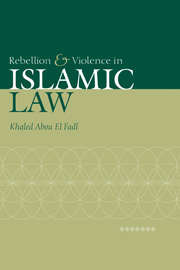Book contents
- Frontmatter
- Contents
- Preface and acknowledgments
- Introduction
- 1 Modern scholarship and reorienting the approach to rebellion
- 2 The doctrinal foundations of the laws of rebellion
- 3 The historical context and the creative response
- 4 The rise of the juristic discourse on rebellion: fragmentation
- 5 The spread of the Islamic law of rebellion from the fourth/tenth to the fifth/eleventh centuries
- 6 Rebellion, insurgency, and brigandage: the developed positions and the emergence of trends
- 7 The developed non-Sunnī positions
- 8 Negotiating rebellion in Islamic law
- Works cited
- Index of names
- Index of subjects
5 - The spread of the Islamic law of rebellion from the fourth/tenth to the fifth/eleventh centuries
Published online by Cambridge University Press: 15 December 2009
- Frontmatter
- Contents
- Preface and acknowledgments
- Introduction
- 1 Modern scholarship and reorienting the approach to rebellion
- 2 The doctrinal foundations of the laws of rebellion
- 3 The historical context and the creative response
- 4 The rise of the juristic discourse on rebellion: fragmentation
- 5 The spread of the Islamic law of rebellion from the fourth/tenth to the fifth/eleventh centuries
- 6 Rebellion, insurgency, and brigandage: the developed positions and the emergence of trends
- 7 The developed non-Sunnī positions
- 8 Negotiating rebellion in Islamic law
- Works cited
- Index of names
- Index of subjects
Summary
ADOPTION AND CHANGE IN THE JURISTIC CULTURE
Abū al-Ḥasan al-Ashcarī (d. 330/941), the founder of the Ashcarī theological school of thought, recites a long list of rebellions in the first two centuries of Islam, and he characterizes some rebels as good, and others as bad. He makes a point of mentioning that many rebellions ended in clemency or pardon, and concludes his recital by emphasizing that cAlī fought those who fought him, but whenever he was asked for a guarantee of safe conduct or amnesty (al-amān), he freely granted it. The idea that Muslim rebels should be treated with a degree of tolerance and with clemency was increasingly taking hold in the culture of jurists. Whether this was a reflection of the socio-historical experiences of Muslims after the third/ninth century is doubtful. Rather, it reflects a doctrinal normative allegiance that had taken hold in Muslim juristic culture. Once legal precedent is set, and the legal culture becomes institutionalized and developed, legal doctrines often assume a life of their own. These legal doctrines set their own base of authority and their own doctrinal imperative. Jurists borrow doctrines from each other, and repeat such doctrines simply because they are a part of an established legal discourse within the juristic culture. Nonetheless, changing sociological and political circumstances, cumulatively and eventually, affect juridical discourses and result in incremental modifications to the law. Sociological and political changes also occasionally result in legal revolutions through which the legal doctrines are substantially and materially altered.
- Type
- Chapter
- Information
- Rebellion and Violence in Islamic Law , pp. 162 - 233Publisher: Cambridge University PressPrint publication year: 2001



